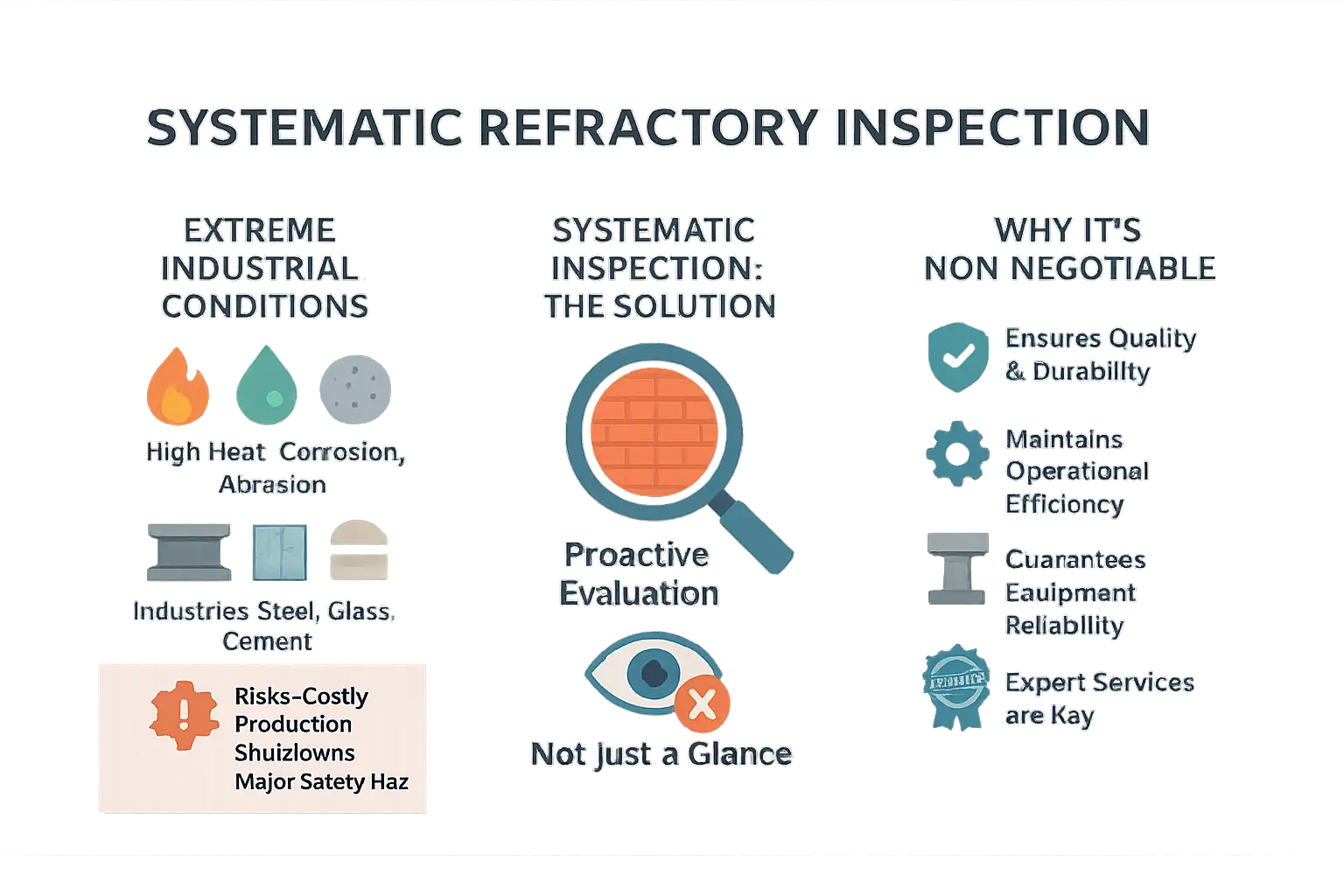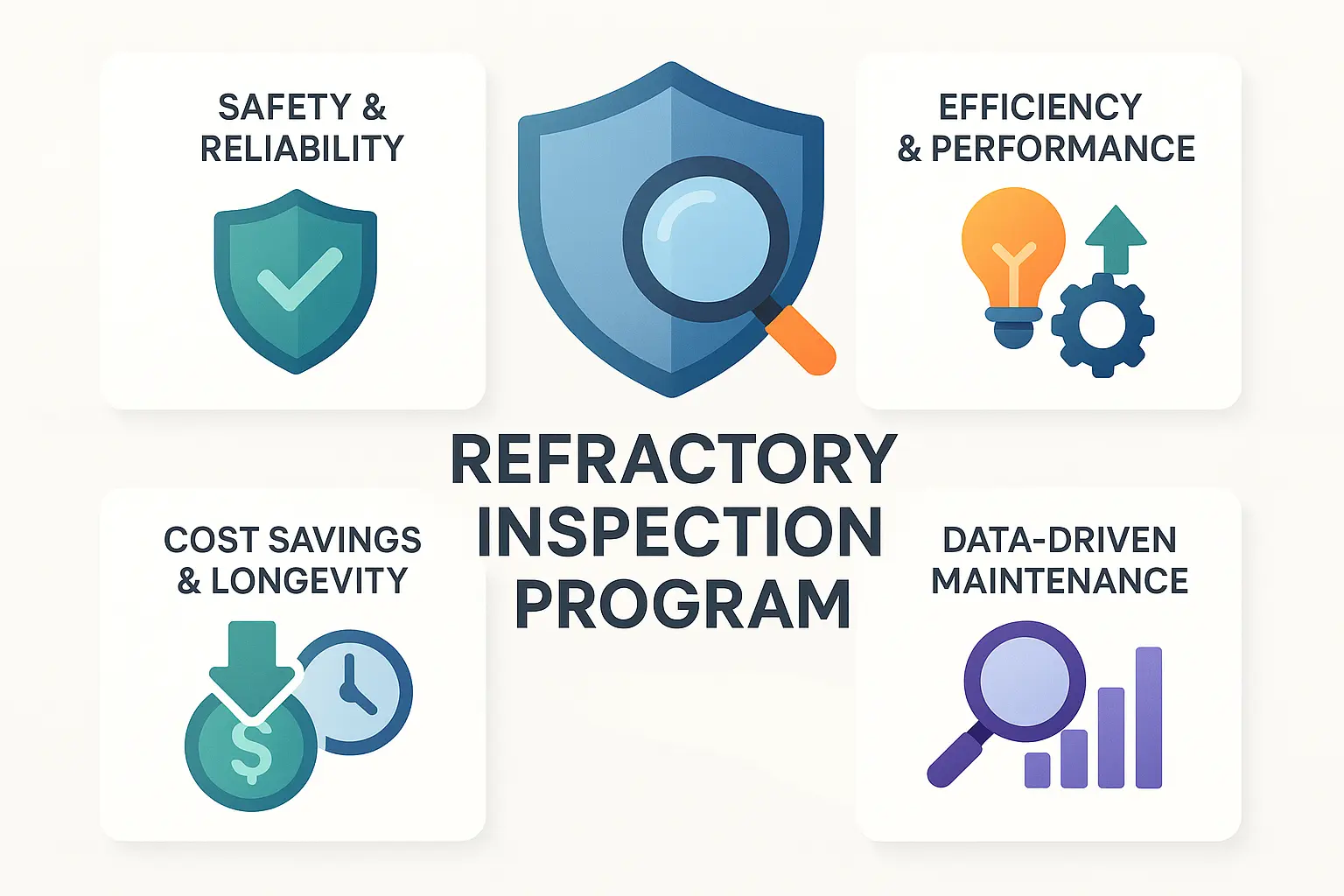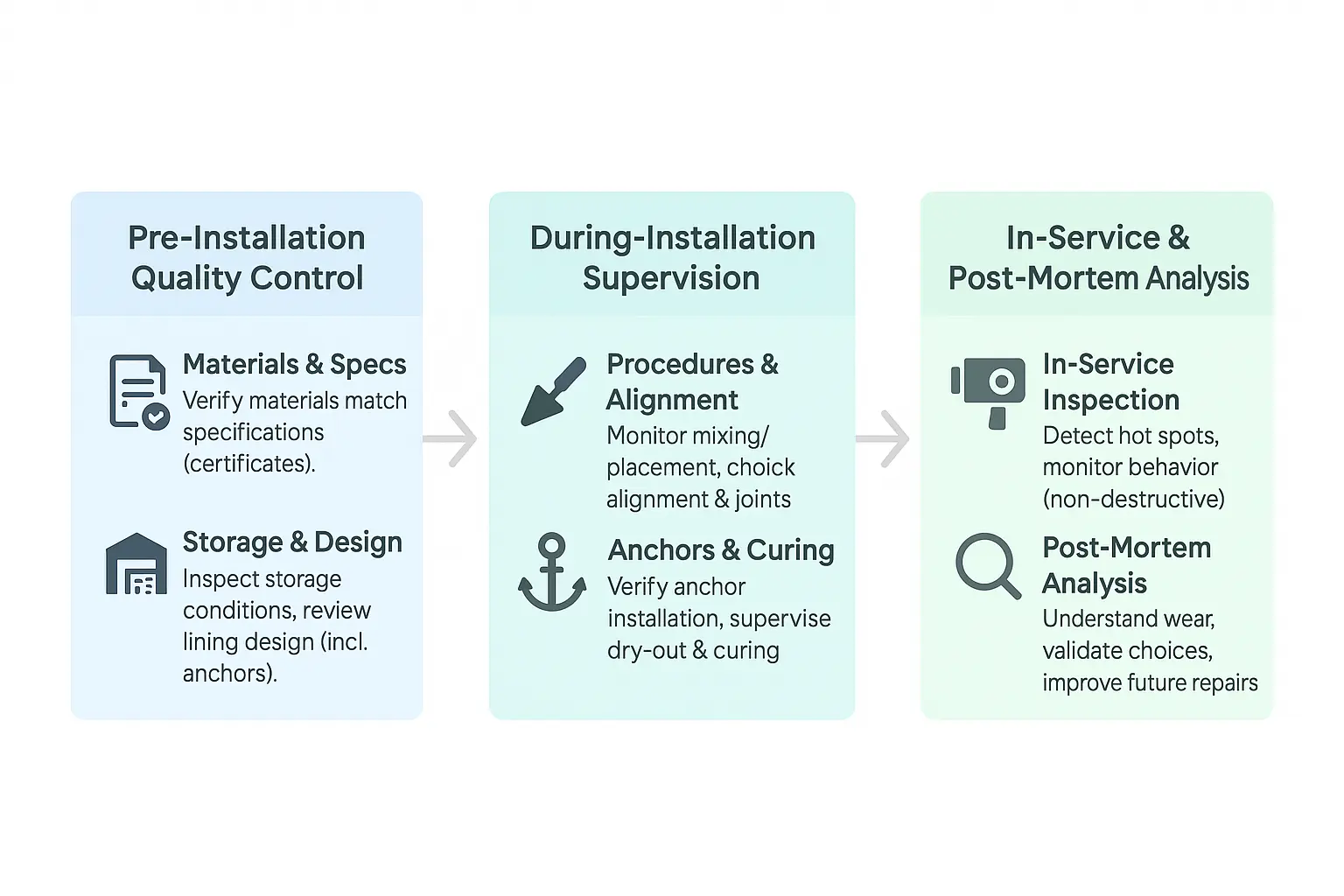Are you risking unplanned downtime, safety hazards, or costly equipment failures by overlooking the silent wear of your refractory linings? Refractory inspection isn’t just a routine check—it’s a critical safeguard against catastrophic failures in high-temperature industries like steel, glass, and cement. This article unveils how systematic evaluations, from infrared thermography to ultrasonic testing, detect hidden flaws, optimize energy efficiency, and align with API standards, transforming maintenance from reactive fixes to proactive quality control. Discover why precision in every hammer test, thermal scan, and material analysis isn’t just best practice—it’s the cornerstone of operational resilience, extended equipment lifespan, and cost-effective longevity in extreme environments.
- Why systematic refractory inspection is non-negotiable
- The critical benefits of a structured refractory inspection program
- What a comprehensive refractory inspection covers
- Key Methods And Technologies In Refractory Inspection
- Navigating industry standards: the framework for quality
- From inspection to action: reporting and maintenance
- Partnering for durability: the future of refractory management
Why systematic refractory inspection is non-negotiable
Industrial furnaces in steel, glass, and cement plants operate under extreme conditions: temperatures exceeding 3,000°F, corrosive chemicals, and mechanical stress. A single refractory failure risks catastrophic breakdowns, posing safety risks and costly downtime. This isn’t routine maintenance—it’s critical for operational continuity.
Systematic refractory inspection is a proactive process using visual checks, ultrasonic testing, and thermal imaging to detect cracks, erosion, or hot spots before failures occur. Unlike reactive fixes, this approach prevents emergency shutdowns costing $50,000+ per hour by enabling scheduled repairs.
Protocols like API STD 936 mandate thickness assessments and crack mapping to predict lifespan. Thermographic cameras identify hidden hotspots, while modeling simulates stress points. These methods ensure linings meet durability standards.
Expert oversight remains vital. Skilled professionals interpret data against benchmarks. For tailored solutions, comprehensive refractory services combine expertise with on-site supervision to maximize asset longevity.
By catching wear early, systematic inspections slash unplanned downtime by 40% and extend lining lifespans by 20–30%. This transforms reactive crises into preventable maintenance, ensuring safety and compliance.

This disciplined approach guarantees refractory systems perform as engineered—protecting productivity through actionable intelligence.
The critical benefits of a structured refractory inspection program

Enhancing operational reliability and safety
Systematic inspections act as an early warning system, identifying cracks, spalling, or structural weaknesses before they escalate into preventing failures. By combining visual checks with tools like thermal imaging and acoustic testing, inspectors detect hidden voids or weakened zones threatening structural integrity. For instance, anchor corrosion—a common failure cause—can be pinpointed early, preventing gas infiltration that accelerates shell oxidation and weakens steel structures. Detecting hot spots or compromised linings reduces risks of molten material leaks, gas breaches, or furnace collapses. This proactive approach safeguards personnel safety, minimizing exposure to hazardous environments and preventing life-threatening incidents that could halt operations entirely.
Maximizing efficiency and performance
Intact refractory linings maintain optimal thermal retention, preventing energy loss through damaged zones. Even minor cracks can increase fuel consumption by 5-10%, inflating operational costs. Regular assessments ensure equipment operates within design specifications, preserving performance thermique optimale and consistent product quality. Thermal imaging tools identify heat escape zones, enabling precise repairs that restore energy efficiency. For example, addressing localized wear in steelmaking furnaces reduces energy waste by up to 15%, improving profit margins. Consistent thermal performance also stabilizes production cycles, ensuring uniform material quality and reducing waste from temperature fluctuations in processes like glass melting or cement clinker production.
Extending equipment lifespan and reducing costs
Unplanned downtime costs industrial facilities millions annually. A structured inspection program converts emergencies into scheduled maintenance, slashing repair expenses. Early detection of anchor corrosion or refractory spalling allows targeted interventions, extending durée de vie du revêtement by 20-30% in some cases. Predictive analytics, like laser scanning, enables data-driven decisions between repairs and full replacements. Tracking wear patterns helps operators schedule maintenance during planned shutdowns, avoiding costly disruptions. Addressing issues like mechanical stress or improper installation early prevents system-wide failures. This approach reduces reliance on emergency repairs, which often require premium labor rates and expedited material deliveries while minimizing production losses.
- Prevention of catastrophic failures and enhanced personnel safety by addressing defects before they escalate.
- Significant reduction of costly unplanned downtime through predictive maintenance strategies.
- Optimization of energy consumption through performance thermique optimale, lowering fuel costs and improving environmental compliance.
- Extension of the refractory’s service life and asset longevity by mitigating wear from thermal cycling and mechanical stress.
- Data-driven insights for future maintenance and material selection, such as corrosion-resistant compositions tailored to specific industrial environments.

What a comprehensive refractory inspection covers
Systematic refractory inspection isn’t just maintenance—it’s a strategic process ensuring operational safety and equipment longevity. By addressing wear, preventing failures, and maintaining efficiency, inspections minimize risks in glass, steel, and cement industries where temperatures exceed 1,000°C. For example, a single refractory failure in a steel ladle can cost $250,000+ in downtime and repairs. Here’s how this lifecycle-driven approach works.
Pre-installation quality control (QC)
Rigorous checks before installation ensure materials meet specifications. Certificates verify chemical composition (e.g., alumina, magnesia) and physical properties like porosity and thermal shock resistance. Improper storage risks contamination, so moisture exposure and physical damage are avoided. Design reviews prioritize refractory anchors—essential for mechanical bonding—and dimensional accuracy to prevent gaps in high-stress zones. Skipping these steps could cause premature failures, costing millions in downtime.
Key tests include Pyrometric Cone Equivalent (PCE) to measure refractoriness—the temperature at which materials soften—and Refractoriness Under Load (RUL) for deformation resistance. For instance, a PCE of 1750°C ensures stability in glass furnace applications. Storage guidelines emphasize humidity control (<70%) and stacking no higher than 2 meters to prevent mechanical damage. These steps ensure materials meet benchmarks before installation.
During-installation supervision
Supervision ensures theory becomes practice. Technicians monitor mixing ratios for castables—too much water reduces strength by up to 30%. For brick linings, alignment and joint spacing prevent thermal stress cracks. The curing phase, where bonds form, requires ideal temperatures (21–32°C). Dry-out schedules must follow guidelines to avoid spalling. Deviations can compromise performance in 1,500°C+ environments.
Hydration reactions in calcium aluminate cement create structure. Rushing dry-out risks steam pockets and explosive spalling. Supervisors use thermocouples to track heat distribution. For thick linings, multi-day plans with gradual ramps ensure structural integrity, avoiding costly rework. For example, a 500mm-thick castable lining might require 96 hours to dry properly, preventing internal fractures.
In-service and post-mortem analysis
Non-destructive testing dominates in-service phases. Infrared thermography identifies hotspots, while fiber-optic sensors like Yokogawa DTSX map temperature changes. Post-mortem analysis reveals wear patterns, validating material choices. This phase drives continuous improvement, linking inspections to the refractory lifecycle.
Tools like FLIR cameras with Regions of Interest (ROI) target high-risk zones in steel ladles, detecting early breaches. ROI settings ignore ambient heat, focusing on critical areas—e.g., a 5–8°C spike in a ladle’s base signals potential failure. Post-mortem studies use data to refine predictive maintenance models, reducing unplanned outages by 35%. By correlating wear patterns with operational data, engineers optimize material selection for specific zones, like slag lines in glass furnaces where corrosion is highest.
Integrating QC, installation oversight, and data-driven analysis transforms reactive repairs into proactive strategies. The result? Reduced downtime, optimized efficiency, and a 30% longer refractory lifespan in modern cement kilns. Each step ensures safe, efficient operation in extreme environments, saving industries an average of $150,000 annually in maintenance costs.
Key Methods And Technologies In Refractory Inspection
Visual And Tactile Inspection
Visual inspection targets high-stress zones like burner ports and exhaust ducts, where thermal or chemical stress accelerates wear. Cracks, spalling, and deformation are flagged early to prevent escalation. For example, a crack near a burner port may signal uneven heat distribution, risking localized overheating. This method ensures surface flaws are addressed before deeper analysis.
The hammer test detects subsurface voids by analyzing sound. A sharp tap produces a clear tone in dense refractory; a dull thud reveals delamination or weak spots. During installation, it confirms compaction of castable materials. In post-mortem reviews, it identifies hidden weaknesses like internal brick loosening.
Advanced Non-Destructive Testing (NDT)
Infrared thermography identifies hot spots indicating refractory thinning or insulation failure. A 70–100°C temperature spike in a steel furnace, for instance, signals a compromised section requiring urgent action. Real-time monitoring allows adjustments during operations, preserving efficiency.
Ultrasonic testing uses sound waves to measure residual thickness. Techniques like Acousto Ultrasonic-Echo track wear in ladles, while StaveCheck™ assesses blast furnace staves. These enable in-service measurements, reducing unplanned downtime and improving lifespan predictions.
Supplementary methods like radar and endoscopy address complex cases. Radar maps thickness via microwaves in non-conductive refractories, while endoscopes inspect internal voids in kilns or furnaces, revealing cracks in inaccessible areas.
| Method | Description | What It Detects | Best Used For (Phase) |
|---|---|---|---|
| Visual Inspection | Direct observation of the refractory surface for visible signs of wear and damage. | Cracks, spalling, erosion, corrosion, deformation, joint degradation. | All phases (Pre-installation, In-service, Post-mortem). |
| Hammer Test | Tapping the surface to assess structural integrity based on the resulting sound. | Voids, delamination, areas of low density, loose bricks. | During installation (checking compaction), Post-mortem. |
| Infrared Thermography | Using a thermal camera to map temperature variations on the equipment’s outer shell. | Hot spots indicating refractory thinning, insulation failure, or internal defects. | In-service. |
| Ultrasonic Testing (UT) | Sending sound waves through the material to measure its thickness. | Residual lining thickness, wear rate over time. | In-service, Post-mortem. |
| Laboratory Sample Analysis | Physical, chemical, and mineralogical testing of samples taken from the lining. | Chemical attack, phase changes, material degradation mechanisms. | Post-mortem. |
A layered strategy combines methods for full coverage. Visual and hammer tests catch surface flaws, while thermography flags thermal anomalies during operation. Ultrasonic testing and radar provide internal wear data, and endoscopy confirms hidden damage. This multi-tiered approach aligns with standards like API 936, ensuring safety and cost efficiency. By integrating basic and advanced techniques, industries minimize risks and maintain productivity in high-heat environments.
Navigating industry standards: the framework for quality
The importance of standardized procedures
Standardized procedures in refractory inspection create a universal language for quality. They define minimum requirements, ensure consistency across installations, and guarantee reliability regardless of location or contractor. Without such frameworks, variations in materials, application methods, and oversight could lead to catastrophic failures in high-temperature environments like glass, steel, and cement plants.
API standards address this by establishing repeatable protocols for testing, documentation, and accountability. They transform subjective judgments into measurable benchmarks, reducing ambiguity in quality assessments. This systemization not only enhances safety but also aligns stakeholders around shared expectations for performance and durability.
A closer look at key API standards
Two cornerstone standards guide refractory quality: API RP 982 and API Standard 936. Both emphasize rigorous inspection, testing, and documentation to prevent premature failures.
API RP 982 focuses on Refractory Installation Quality Control—Inspection and Testing Monolithic Refractory Linings and Materials. It covers the entire quality control (QC) lifecycle, including:
- Material property evaluation and lining design
- Pre-installation QC plans and acceptance criteria
- Repair methodologies and documentation practices
API Standard 936 expands this scope, detailing requirements for installation, testing, and repair of monolithic linings. It mandates qualifications for inspectors, defines QC phases (pre-installation, during installation, post-installation), and establishes protocols for material testing, surface preparation, and drying procedures. Crucially, it specifies criteria for physical properties like cold crushing strength and linear shrinkage in Table 3, ensuring materials meet exacting performance thresholds.
The quality control (QC) process and stakeholder roles
Effective QC hinges on clear roles:
- Owner: Sets technical requirements, approves plans, and resolves deviations.
- Contractor: Executes installations adhering strictly to API standards and project specifications.
- Inspector: Acts as an independent quality gatekeeper, verifying compliance through testing, audits, and documentation reviews.
For example, inspectors oversee pre-installation material qualification tests, monitor installation activities, and validate final curing processes. Post-installation, they conduct hammer tests and visual inspections to identify defects. Non-compliance at any stage risks compromising equipment integrity—a reality underscored by common refractory failures linked to procedural shortcuts.
Certified inspectors under API 936 bring specialized expertise, having demonstrated mastery through rigorous exams covering installation, repair, and testing protocols. Their role ensures adherence to standards like API 936’s requirement for “as-installed” sample testing, which confirms physical properties align with Table 3 specifications. This multi-layered approach transforms quality from a vague ideal into a quantifiable, enforceable discipline.
From inspection to action: reporting and maintenance
Identifying and classifying common defects
Refractory materials endure extreme stresses, making defect identification crucial. Cracks split into thermal (temperature-driven) and mechanical (stress-induced) types. Horizontal cracks signal thermal stress, while diagonal patterns indicate mechanical strain from forces like kiln rotation.
Spalling—surface flaking—stems from thermal shocks or poor installation. This weakens structural integrity, letting corrosive agents penetrate. Spalling insights prevent cascading failures. In glass furnaces, burner port spalling accelerates wear due to temperature gradients, requiring monolithic linings.
Erosion (abrasion from particle flow) and corrosion (chemical reactions with molten materials) demand targeted fixes. Both need urgent action to avoid breakdowns. Silica-based refractories in aluminum smelters corrode rapidly under basic slags, requiring material upgrades.
Structuring an effective inspection report
A concise report merges technical precision with actionable insights. Key elements include:
- Executive Summary: Quick condition overview and critical priorities.
- Scope and Methodology: Thermography for hotspots, ultrasonic testing for internal flaws.
- Detailed Observations: Mapped defect locations with measurements.
- Defect Classification: Link cracks to stress types, spalling to installation issues.
- Actionable Recommendations: Repair timelines and material upgrades.
- Prioritized Action Plan: Critical (immediate shutdown), high (next maintenance), or medium (monitoring).
Translating findings into a maintenance strategy
Inspection data drives refractory maintenance. Prioritized plans cut unplanned downtime, which costs millions yearly. Early spalling fixes prevent molten leaks threatening safety and equipment. In cement plants, 70% of outages stem from refractory failures, highlighting repair urgency.
Aligning maintenance with operational cycles reduces losses. Historical data guides material choices—high-alumina bricks for corrosion zones, silicon carbide for steel ladles. Predictive methods using thermal imaging cut emergencies by 40% in glass furnaces.
Proactive planning works: facilities with structured reports see 30% fewer stoppages. By converting insights into predictive plans, companies protect assets and ensure consistent output in glass, steel, and cement production. Annual FCCU (fluid catalytic cracking unit) checks extend refractory life by 25%, boosting petrochemical ROI.
Partnering for durability: the future of refractory management
Systematic refractory inspection isn’t a cost—it’s a strategic investment. By identifying wear early, industries avoid catastrophic failures, reduce unplanned downtime, and extend equipment lifespan. For sectors like steel, cement, and energy, where high-temperature processes dominate, proactive monitoring ensures quality remains uncompromised and durability meets operational demands. The stakes? Unchecked degradation risks safety hazards, environmental violations, and revenue losses skyrocketing into thousands per hour.
A data-driven approach defines modern refractory management. Standardized protocols—like thermographic imaging, ultrasonic thickness testing, and ASTM-compliant material analysis—transform reactive fixes into predictive strategies. Industry leaders prioritize partnerships with firms offering global expertise in custom solutions, ensuring materials align with thermal, chemical, and mechanical stresses. These collaborations turn maintenance into a competitive edge, blending cutting-edge diagnostics with field-proven methodologies to optimize asset performance.
Ultimately, long-term reliability hinges on expertise. Partnering with a global leader in refractory solutions ensures every inspection translates to smarter outcomes: fewer repairs, higher efficiency, and prolonged equipment integrity. As industrial demands evolve, the fusion of material science and proactive oversight becomes non-negotiable—a safeguard against escalating risks and a blueprint for sustainable success.
Systematic refractory inspection is a strategic investment in operational reliability, safety, and cost efficiency. By adopting a proactive, data-driven approach aligned with rigorous industry standards like API, companies ensure optimal performance and longevity of high-temperature assets. Partnering with experts in custom refractory solutions transforms inspections into actionable insights, driving smarter decisions for sustained industrial excellence.
